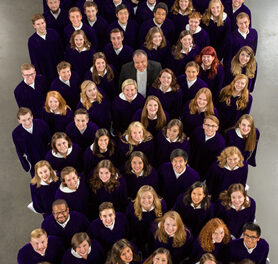Thomas Joiner has been Music Director of the Hendersonville Symphony Orchestra for more than a third of the orchestra’s forty-year history. When I first heard them in 2000, the musicians lived up to their advance reputation: This is an orchestra that is better than it has any right to be. How can a city of 10,000 and a county of less than 100,000 people field an orchestra that plays this well? On Saturday, March 10, they culminated a five-year plan of performing all nine of Beethoven’s symphonies by delivering a sensitive and faultless Ninth Symphony.
For the event, Maestro Joiner convinced the orchestra’s board to pay for six rehearsals rather than the usual four. The result was a solidly prepared ensemble that had gone far past dealing with the technical complexity of the monumental work, and was deeply into feeling the aesthetics of the piece. In the first movement, the string players produced a taut disciplined long line, showing introspection in their delivery of contrapuntal details as part of a coherent whole. The movement gave the listener a feeling of determination and introspection. The second movement was an insistent and driven Molto Vivace. The players handled the accelerandos uniformly and with ease. The third movement, a serene and ethereal Adagio, is broken towards the end by a “call to attention” from the brass that presages the “call to brotherhood” that will occur in the final movement, when the orchestra is joined by four vocal soloists and a ninety-member chorus.
Normally, that Adagio leads directly into the fourth movement. Logistics dictated the one regrettable element of the performance. The stage of the Blue Ridge Conference Hall, even with an extension, could not accommodate seating for the chorus. The chorus remained back stage during the three movements and then stood on stage throughout the fourth movement. An intermission was taken between movements to allow the chorus to take their places.
Wolfgang Mozart often treats instruments in a vocal manner. In contradistinction, Beethoven treats voices in an instrumental manner. In particular, chorus members are asked to sing well above their usual ranges. I contend that Beethoven, though deaf, knew exactly what that would sound like – a little strained and urgent – and that was the sound he wanted. The Asheville Symphony Chorus, prepared by its Director, Dewitt Tipton, delivered: their intonation was fine and they showed conviction in their German diction. The four soloists were Jacquelyn Culpepper, Mary Gayle Greene, David Moffitt and Dan Boye, all of whom live and teach in North Carolina. While all were in good voice, Ms. Culpepper was the standout in terms of phrasing and delivery.
A sold-out crowd of 700 (a smaller capacity than other concerts because the stage extension cut into the floor space) was appreciative, calling the soloists, chorus director and Maestro Joiner back to the stage four times.
My history with the Beethoven Ninth goes back many years. I heard it performed by the Winnipeg Symphony Orchestra when I was quite young. A few years later, I sang in the chorus with the Minnesota Orchestra under Antal Dorati. Since then, I have heard the work live at least six times by major orchestras in Detroit, Rochester, New York and Washington. Those concerts included orchestral musicians of great distinction – oboist Rhadames Angelucci, clarinetist Stanley Hasty, hornist Morris Secon, cellist Lorne Munro, violinist Rafael Druian – who outgun our local players. But in terms of respecting Beethoven’s intent and delivering an ensemble performance, the Hendersonville Symphony Orchestra stands shoulder to shoulder alongside those more illustrious bands. Joiner and the HSO should be very proud.











